-
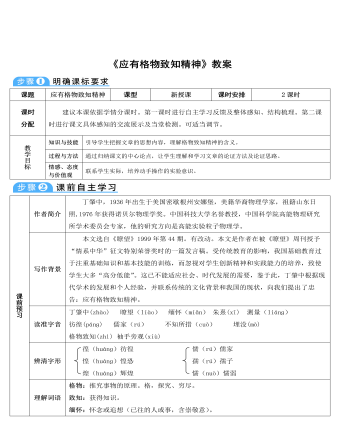
部编版语文八年级下册《应有格物致知精神》教案
【深入研读,探究方法】1.思路清晰、缜密。开头紧扣论题,由“格物致知”的出处,引出对其含义的理解以及我国古代并不重视真正的“格物致知”的原因分析,澄清人们的错误认识;接着作者从实验过程的两个特点、中国学生存在的问题和作者自己的亲身经验三个方面分析真正的“格物致知”精神的重要性;最后指出真正的“格物致知”精神的两个意义,并发出号召。全文思路清晰,说理严密。2.举例论证、道理论证和对比论证相结合,论述充分有力。文章在列举事例时,采用正面事例和反面事例相结合的说理方法。如反面事例,文中第4段举了王阳明“格”竹子的事例,证明了中国传统的教育并不重视真正的格物致知;在第11段摆了中国学生大都偏向理论轻视实验的事实;第12段又举了自己到美国念物理时吃的苦头。
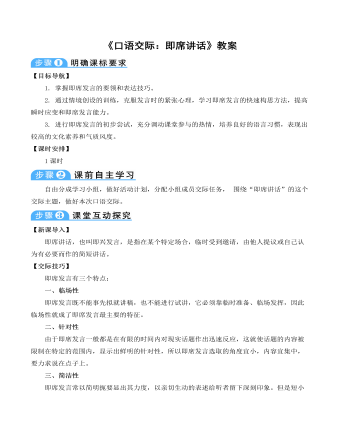
部编版语文八年级下册《口语交际:即席讲话》教案
【目标导航】1. 掌握即席发言的要领和表达技巧。2. 通过情境创设的训练,克服发言时的紧张心理,学习即席发言的快速构思方法,提高瞬时应变和即席发言能力。3. 进行即席发言的初步尝试,充分调动课堂参与的热情,培养良好的语言习惯,表现出较高的文化素养和气质风度。【课时安排】1课时自由分成学习小组,做好活动计划,分配小组成员交际任务, 围绕“即席讲话”的这个交际主题,做好本次口语交际。【新课导入】即席讲话,也叫即兴发言,是指在某个特定场合,临时受到邀请,由他人提议或自己认为有必要而作的简短讲话。【交际技巧】即席发言有三个特点:一、临场性即席发言既不能事先拟就讲稿,也不能进行试讲,它必须靠临时准备、临场发挥,因此临场性就成了即席发言最主要的特征。
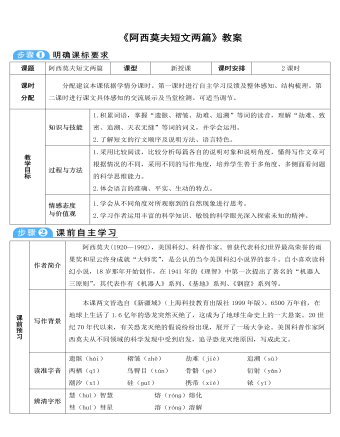
部编版语文八年级下册《阿西莫夫短文两篇》教案
第一部分(第1~4段),提出关于6500万年前恐龙灭绝的问题,目前存在的两种对立的理论,即“撞击说”和“火山说”。第2和第3自然段先后举了两个例子提出了关于“撞击说”和“火山说”这两种观点。第二部分(第5段至全文完),通过对“被压扁的沙子”的反思,证明外星撞击导致恐龙灭绝,支持“撞击说”。这部分又分四层。第一层(第5、6段),说明关于恐龙灭绝的原因不仅仅是一个学术问题,我们以后也许还会遇到这种情况,因此,科学家们一直都在努力寻找证据来验证这两种理论。第二层(第7~10段),说明1961年一位苏联科学家发现了“斯石英”,并且介绍了它的性质,为下文佐证“撞击说”奠定了基础。第三层(第11~13段),说明斯石英不仅可以在实验室制造,而且它在自然界中是可以存在的,不过它们只出现在沙子被强烈挤压的地方。由此推断撞击是可以产生斯石英的。事实也证明,火山喷发是不会产生斯石英的,从而进一步佐证了“撞击说”。

部编版语文八年级下册《在长江源头各拉丹冬》教案
【深入研读,探究方法】1.语言优美,通俗易懂,妙笔生花。文章中运用“静穆”“晶莹”“熠熠烁烁”这些优美鲜活的词语,生动形象地描绘了各拉丹冬的千姿百态,壮观奇景,使文章更加的灵动,给人以无限美感。作者以自己的游览经历讲述,语言平实,浅显易懂。2.主题鲜明,意味深长。文章主要讲述作者的一次雪域高原之游,描写了各拉丹冬美丽壮观的景色和作者攀登的经历,给我们以启示:做任何事情要不放弃,不半途而废,勇往直前就能达到自己想要的目标。3.善用比喻,生动形象。文中处处可见比喻的修辞手法,“阳光……巨人” “像长发披肩”都运用了比喻的修辞手法,使各拉丹冬的景色更生动具体,富有感染力,给人以深刻的印象,引发读者的联想和想象。
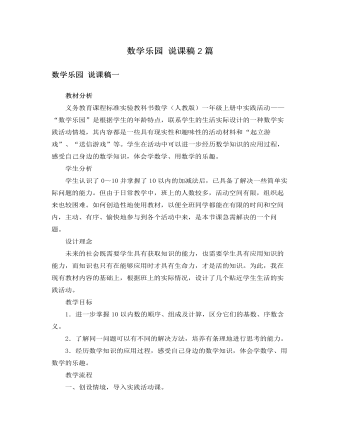
人教版新课标小学数学一年级上册数学乐园 说课稿2篇
这是一个所有学生都非常熟悉的学习生活事例,这个事例中包含着基数和序数知识。通过这个活动,可以使学生实实在在地体会到生活中的数学,切实感受数学与自己学习生活的密切联系,使他们学会用数学的眼光去观察身边的事物。5、锤子、剪刀、布这是一个学生都非常感兴趣的游戏,游戏蕴涵了统计和比多少的知识。这样既巩固了比多比少的知识,又使学生体会了比多少的知识在实际生活中的应用,同时还让学生学习了简单的数据整理的方法。教学目标:1、进一步掌握10以内的数的大小顺序,加深对基数和序数的认识,以及10以内数的加减法,提高口算能力。2、灵活运用知识解决问题的能力和与他人团结合作的能力3、培养学生团结合作的意识,体验学数学、用数学的乐趣。

人教版新课标小学数学一年级上册用数学 说课稿
人教版数学第一册第47页《用数学》这一课的内容是为了让学生学会用6、7的加减法解决生活中实际的计算问题,它是在学生认识了加法和减法的意义、初步掌握了6、7的加减计算方法的基础上进行教学的。学生在这一节课中学习方法、能力的培养将对今后进一步用数学知识解决生活中的实际问题起到重要的作用。教材第47页集中安排了一组以“金色的秋天”为主题的“用数学”的内容,包括例题中的4+2=6和7-3=4以及相对应的做一做的简单求和与求剩余两个问题。与此同时还出现了大括号表示把两部分合起来以及用问号表示要求的问题。这是教材第一次出现这种形式的内容,它是一种用情境图反映的数学问题,有利于学生将所学数学知识同生活实际紧密结合起来,并在生活中去发现数学问题解决问题,从而发展解决简单实际问题的能力。为了巩固学生的这一能力,教材还在第52页配备了同一类型的保护小动物为主题的练习。
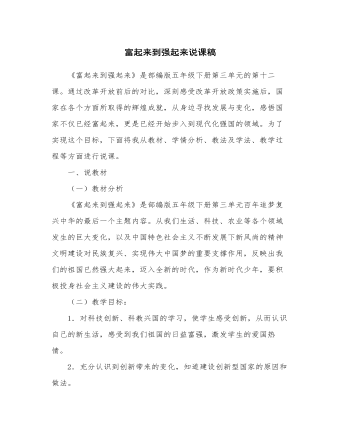
人教部编版道德与法制五年级下册新版富起来到强起来说课稿第二课时
1.看过了视频,接下来由各个小组与我们分享他们在课下准备的核心价值观小品,每组表演时,剩下的小组猜测表演的是哪一个核心价值观并在活动评价单上进行评分。2.教师总结:“精神文明建设使人们的生活更美好”教师引导学生:精神文明建设搞好了,人心凝聚,精神振奋,各项事业才会全面兴盛。活动二:走进新时代,怀揣中国梦。1.播放“中国梦”优秀少儿演讲视频。2.阅读课本,交流感想。活动三:争做时代好少年1.回顾各小组的表演,把其中所有的不良习惯和闪光举动逐个挑出来再次强调。2.小组交流班级内部常见的坏习惯。教师总结。总结延伸:通过本节课的学习了解到青少儿应积极投身于社会主义精神文明建设的伟大实践中去,做新时代的好少,做新时期中国先进文化的传播者。
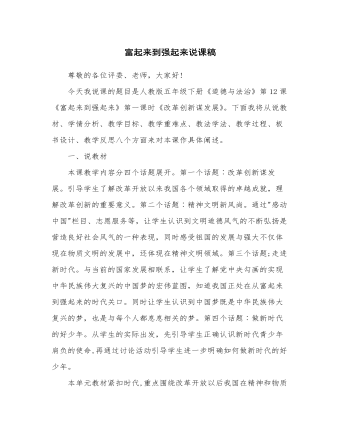
人教部编版道德与法制五年级下册新版富起来到强起来说课稿第一课时
阅读教材第88、89页内容,思考︰(1)"新四大发明"出现的主要原因是什么?(2)科技创新与国家发展、人民生活有什么关系?(3)改革创新对于一个国家和民族有什么重要作用?提示︰(1)改革创新的实践以及"科教兴国"战略的落实。(2)促进了经济领域的飞速发展,也促使科技、文化、生活等各个领域取得辉煌成就,不断推动社会的进步和国家的富强。只有在不断改革创新中,一个民族的凝聚力才能不断增强,一个国家的生机活力才能不断焕发。弘扬以改革创新为核心的时代精神,努力投身创新实践,发展才会有新思路,改革才会有新突破,我们才能开创更加美好的未来。第三个环节:课堂小结改革创新是时代的最强音。只有在不断改革创新中,一个民族的凝聚力才能不断增强,一个国家的生机活力才能不断焕发。

人教部编版道德与法制五年级下册新版屹立在世界的东方说课稿第一课时
讨论交流:正是靠着这种民族精神,我国建成了一个个大油田。到1965年,中国的石油基本实现自给。5、补充资料1964年10月16日和1967年6月17日,中国西北罗布泊大漠中,升起了蘑菇状的烟云。我国相继成功爆炸了第一颗原子弹和第一颗氢弹,成为继美国、苏联、英国之后第四个同时拥有原子弹和核弹的国家。中国从此拥有了保家卫国、捍卫和平的核力量。交流邓稼先故事1950年8月,邓稼先在美国获得博士学位九天后,便谢绝了恩师和同校好友的挽留,毅然决定回国。同年10月,邓稼先来到中国科学院近代物理研究所任研究员。在北京外事部门的招待会上,有人问他带了什么回来。他说:“带了几双眼下中国还不能生产的尼龙袜子送给父亲,还带了一脑袋关于原子核的知识。”此后的八年间,他进行了中国原子核理论的研究。
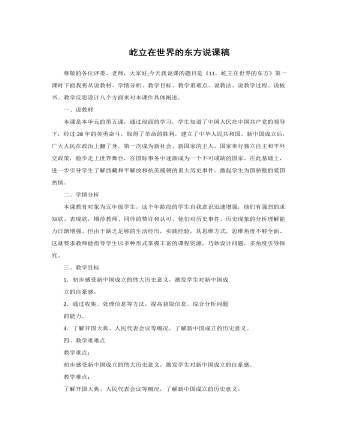
人教部编版道德与法制五年级下册新版屹立在世界的东方说课稿一、二课时
(1)这个故事的什么地方最令你感动?(2)你从这个故事中看到邓稼先怎样的奉献精神?1950年,新中国诞生的消息传到了大洋彼岸,年仅 26岁的邓稼先刚刚取得学位,毅然放弃了在美国优越的生活和工作条件,冲破重重阻挠回到祖国。1958年,他接受国家最高机密任务秘密研制原子弹。从此,邓稼先隐姓埋名28年,连家人也不知他的去向,一直奋战在我国西部荒漠中的核基地。在一次航投试验中,原子弹意外摔裂。邓稼先明知危险,却一个人跑上前去亲自察看,导致身体邓稼先受到核辐射的致命伤害。他忘我地工作,和许多著名科学家同心协力,攻破一道又一道科学难关,终于为祖国点燃了那饱含着我国科学家们智慧和力量的神奇之火。1986年7月29日,他临终前留下的话仍是如何在尖端武器方面努力,并叮嘱:“不要让人家把我们落得太远……”4.你还知道哪些为新中国作出贡献的科学家?你能说说他们的故事吗?(1)华罗庚:梁园虽好,非久居之地1950年3 月,来自美国的“克利夫兰总统号”邮轮航抵香港,略作停留,进行补给。

人教版新目标初中英语七年级下册I ’d like some noodles教案
教学过程Step 1: warming-up Sing a song---------“food and drink” Step 2: Revision1 Dictation2 Revise: What kind of noodles would you like?I’d like …What size bowl of noodles would you like?I’d like…Step 3: Presentation1 show pictures of food, ask students say the words.2 Students read the newspaper ad in 3a. Fill in blanks with words in the box. Then read the ad together, the teacher explains some difficult language points.3 Check the answers Step 4 PracticeAsk students to finish 3b in the same way according to 3a. Students read the short passage and fill in the blanks .At last, check the answers.Step 5 productionAsk students to write their own ad for dumplings, noodles, drinks, and other foods they know. Then ask students to read their partner’s ad. Then order food and drink from their partner.Step 6 Home workGroup work – make an ad about “food and drink”

人教版新目标初中英语七年级下册I want to be an actor教案2篇
三、教学建议第一课时:1. Lead in (Vocabulary)A) Before class, teacher should collect some pictures of working places. For example: Bank, TV Station, Restaurant, Police Station, Hospital ...B) In class, show students the pictures (PowerPoint, OHP). Ask students to tell the name of the working places and the name of the jobs.Shop assistant, doctor, actor, reporter, police office, waiter, bank clerk, studentC) Do exercise 1a and 3a.2. Bingo GameAsk groups of students to make up pairs of cards with a job on one and the related workplace on the other. For example, waiter / restaurant, teacher / school, doctor / hospital. Encourage students to use both the job / workplace combinations in the book and the ones that students came up during class discussions. Be sure they have twice as many sets of cards as there are students in the group. They can make two sets of cards for a single job / workplace, if necessary. Then have each group mix up its set of cards and hand their cards out in random order. Each time a student gets a pair of cards that match, he or she can lay these cards down. The goal is to have no cards in your hand at the end.3. Task OneA) Ask students to work in pairs and ask the partner what does he / she want to be in the future.e. g. :What do you / does he / does she want to be?I want to be a.Why?Because it's (adj).B) Vocabulary: Section B, 1a4. Homework 1.2.

人教版新目标初中英语七年级下册Where did you go on vacation教案
句型: Where did you go on vacation? I went to summer camp.Did she go to Central Park?Yes,she did.No, she didn’t语法:一般过去时特殊疑问句、一般疑问句及肯、否定回答。课时安排4课时第一课时:Section A:la,1b,lc,2a,2b,2c 第二课时:Section A:3a,3b,4第三课时:Section B:1,2a,2b,2c第四课时:Section B:3a,3b,3c,4 and Self Check第一课时教学目标掌握描写假期生活的形容词。假期里自己所做事情的简单表达。谈论假期做的事情及当时情况。谈论假期时旅游的天气,旅游者以及食物等。教学过程一、导入播放一首英文歌曲:Let’s travel 说明:通过让学生听节奏欢快迪斯尼英语歌曲Let’s travel.引入本节课谈论的话题vacation and travel. 让歌曲使学生的思维活跃,增强课堂气氛,激发学生提高学习英语的兴趣。T:How is the trip ?Ss : It’s pretty good/ happy/exciting /relaxing/busy/dangerous/ fantastic说明:这个问题是为了操练形容词。建议让多个Ss作答。鼓励他们用不同的形容词。上述个别形容词本应在第二课时中出现,但可以在warming-up中第一次非正式出现。这些形容词也可在老师的评价语中适时出现,以加深学生对词汇的印象。

人教版新目标初中英语七年级下册Why do you like koalas教案2篇
单元整体说明(一)单元教材分析本单元的核心话题是描述动物和表达个人喜好,以及句式why do you like…? Because…。这也是本单元的教学重点。通过本单元的学习,学生应能较流利地运用所学词汇和句型描述动物,表达个人喜好。(二)单元知识结构1.词汇动物名称 tiger, elephant, koala, dolphin, etc.词汇描述性形容词: smart, cute, ugly, clever, shy, etc.国家名: Australia, South Africa2.句型Why do you like koala hears? Because they are cute.Where are pandas from? They're from China.What animals do you like? I like dolphins.(三)单元整体目标1.Master the vocabulary2.Master and use: Why do you like koalas? Because they am cute.Where are pandas from? They're from China.What animals do you like? I like dolphins.(四)单元教学重难点一览(五)单元学情分析学生此前已经学过由why, where, what 引导的特殊疑问句句型,具有了学习本单元知识的认知前提。形形色色的动物能激发学生的好奇心,产生了解它们的欲望,这有利于本单元知识的教学和学生学习兴趣的培养。

人教版新目标初中英语七年级下册How was your weekend教案2篇
Teaching Goal:1. General aims:Talk about recent past events2. Particular aims:A. Language Focus.Talk about recent past events and think of the past events.B. Language goalsHow was….?It was …What did …do over the weekend?C. Language structures:(1). How was your weekend? I was great. Pay attention to no form.(2). What did you do over the weekend? I played soccer. We went to the beach.D. Useful words and phrases:Words: was, did, went, beach, over, project, test, wasn’t, false, number, geography, spend, week, most, mixture, their, had, little, cook, read, saw, change, everyone, sit, sat, no, anythingPhrases: did one’s homework, played soccer, cleaned my room, went to the beach, played tennis, went to the movies, on Saturday morning, over the weekend, cook … for, what about, do some reading, have a party, talk show, go shoppingE. Grammar language:Present simple past tenseRegular and irregular verbsF. Learning strategies:Tour and holidaysG. Interdiscipinary:H. Emotion and manner:Teaching time: 5 periodsTeaching procedures:Period One教学步骤、时间 教师活动 学生活动 媒体应用Step 1Free talk 3’ Ask some questions like:Who’s on duty today?What’s the weather like? Answer and talk about something.让同学们回答下列问题1. Do you like weekend? (Let some students answer)It takes them three minutes to talk about the question.2. Why do you like weekend? (let the students answer) Most of the students like the weekend此时教师用汉语问:“在周末期间问你干了什么?这句话用英语这么回答?Let the students guess.At last the teacher give them right answer3. What did you do over the weekend?(板书、学习)

人教版新目标初中英语七年级下册What does he look like教案3篇
所需要用到的句子:Who is that?That is Jack. I like him.Why do you like him?I like him because he is interesting.Task 4: 设计理想中的人类Step one: 设计理想中的人类的外貌。把全班同学分成若干小组,学生可以边说边在纸上画出他们的模样。Step two: 设计理想中人类的性格。学生们可以把那些能描述性格的单词写在图画的旁边。Step three: 每组选出一名同学,其他同组同学提问,他作简单回答,并说明原因。所需用到的句子:What does he or she look like?He or she ...What is he or she like?He or she is ...Why?Because ...Task 5: 挑战性活动调查性格是天生的还是后天形成的,让每个同学回家去调查一下自己成长过程中性格是否有变化,具体是怎样的,为什么会这样? Teaching Aims:1. Enable students to have a general understanding of how to talk about people's physical appearance.2. Enable students to tackle some essential vocabularies and patterns about describing people. Provide them with necessary skills and methods.3. Create various chances for students to describe the persons they're familiar with, such as classmates, family members, teachers, idols, etc.

人教版新目标初中英语七年级下册Where is the post office教案2篇
Period 2 (3a----Section B 2c)Preview(Pre-task): Key points: What laAdd another information about their pen pals----their language on the cardnguage does she/he speak?She/He speaks....Does she/he have any brothers and sisters? Does she/he speak English?Preview(Pre-task): Add another information about their pen pals----their language on the cardKey points: What language does she/he speak?She/He speaks....Does she/he have any brothers and sisters? Does she/he speak English?Step 1 Revision1.Revisionand dictation of the new words 2.Revise the drills they learned yesterday.(by pairwork and grammar exercise)Step 2 Leading-inT has a conversation with one student. The conversation is following:---Do you have a pen pal?---Yes, I do.---What's your pen pal's name? ---His/Her name is....---Where is your pen pal from? ---He/She is from...---Where does he/she live? ---He/She lives in....---What language does he/she speak?He/She speaks...Write the new words on the Bb. They are following: EnglishChineseJapaneseFrenchStep 3 LearnLearn the new words with the whole class.Finish 3a with the students3b Pairwork T still does an example with one student Then the Ss practise in pairs. The example is following:--Curry Muray is my pen pal. He is from the United States.---What language does he speak?

人教版新目标初中英语七年级下册Don’t eat in class教案2篇
Don’t fight. =You can’t fight. (板书,教读)教师把这些句子板书在黑板上,并请学生大声整齐地读祈使句和“can’t”句型,并让学生注意两种句型表达形式的不同和转换,“Don’t …=You can’t…”;并对学生说:These are our school rules. (板书,教读) You can’t break the school rules. Don’t break the school rules.(板书,教读)步骤3 :Practicea. T: Now, each of the students is breaking one of these rules.Please finish 1a.学生看图,完成1a的内容,检查答案并大声朗读校规。b. 听录音,完成1b,选出四位学生都违反了哪条校规;听之前,学生要读会英文名。c. 请两位学生朗读1c部分的句型;要求学生两人一组对话表演,SA扮演外校转来新生,SB告知本校校规。(学生可经过讨论,多说出他们想到的校规,不必只限于书上;教师应给予帮助)2) 第二课时(2a~4)步骤1 :warming up of revisionT: What are the rules at your school?学生使用“can”或祈使句表达各条校规;其中老师可引出“eat in the cafeteria outside”的表达。步骤2 :Practicea.T: Christina is an exchange student. She doesn’t know the rules. Let’s listen, what activities they’re talking about?学生听第一遍时,完成2a;第二遍时,完成2b;b. 请学生领读2c部分,看着2a完成的表格,理解2c活动的要求;分成小组针对2a进行问答;

人教版新目标初中英语七年级下册Where is your pen pal from教案
2.1Match the country with the language.Step II Reading3a? let the students read the letter fast and answer the questions.? Let the students ask more questions about the letter as possible as the can.Step III Writing3b.Step IV. Pairwork2cStep V Listening2a, 2bStep V. HomeworkExercises book(1) P3Exercises book (2) P3Period FourStep I . Dictate the words and sentences in Unit1.Step II. Self-checkStep III. Check the answers for Exercises book in the unit.Step IV. Home workRevise and preparation for unit 2.教学反思:通过本单元的学习,学生基本可以谈论人们的国籍,居住城市及其所说的语言,通过书信方式去介绍自己并寻找笔友。但在涉及到国外的一些城市时,学生对这方面的知识相对欠缺,能介绍的城市并不多,也反应出学生课前预习不充分,这跟学生学习条件也有关,大多数学生无法通过网络获取所需信息。因此,在以后的教学中要多指导学生通过计算机网络获取信息,拓宽知识面。

人教版新目标初中英语七年级下册What do you think of game shows教案
五、教学Section B-2c1. Pair work: What do you think of the belt/sunglasses/…? What does your father/mother/… think of your scarf/belt…?2. Group work(1). Teacher shows some different kinds of school uniforms (制服)and asks : “ What do you think of your school uniforms? If you have a chance to choose your school uniforms, what kind would you like to choose?”(2). Discuss in groups.(3).Get some Ss to report in class.说明:这一步旨在让学生运用已有的语言知识谈论对事物的看法和意见,并简单阐明理由,培养学生的主动思维能力和运用英语的能力。六、教学拓展调查电视节目的收视率任务:调查你周围的人对现在各种电视节目的反响。活动过程:1.教师布置任务,让学生调查周围的人(包括他的亲戚朋友和邻居)喜欢收看哪方面的电视节目。2.学生进行调查活动,运用本单元所学的句型What do you think of….? (Why?)What's your favorite game shows?What do you think of talk show?I doesn’t mind it.I like it.I love it.I can’t stand it.3.记录下排在前10位的TV Program,填写调查表,比较其收视率。

